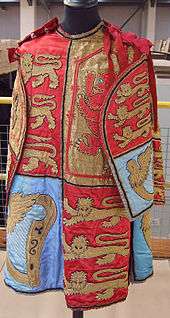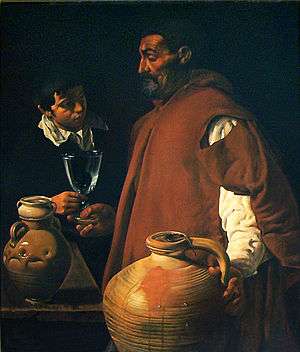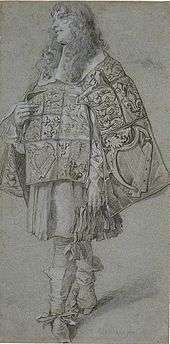Tabard

A tabard is a short coat common for men during the Middle Ages. Generally used while outdoors, the coat was either sleeveless or had short sleeves or shoulder pieces. In its more developed form it was open at the sides, and it could be worn with or without a belt. Though most were ordinary garments, often workclothes, tabards might be emblazoned on the front and back with a coat of arms (livery), and in this form they survive as the distinctive garment of officers of arms.
In modern British usage, the term has been revived for what is known in American English as a cobbler apron: a lightweight open-sided upper overgarment, of similar design to its medieval and heraldic counterpart, worn in particular by workers in the catering, cleaning and healthcare industries as protective clothing, or outdoors by those requiring high-visibility clothing.
Middle Ages

A tabard (from the French tabarde) was originally a humble outer garment of tunic form, generally without sleeves, worn by peasants, monks and foot-soldiers. In this sense, the earliest citation recorded in the Oxford English Dictionary dates from c.1300.[1]

By the second half of the 15th century, tabards, now open at the sides and so usually belted, were also being worn by knights in military contexts over their armour, and were usually emblazoned with their arms (though sometimes worn plain). The Oxford English Dictionary first records this use of the word in English in 1450.[1] Tabards were apparently distinguished from surcoats by being open-sided, and by being shorter. In its later form, a tabard normally comprised four textile panels – two large panels hanging down the wearer's front and back, and two smaller panels hanging over his arms as "sleeves" – each emblazoned with the same coat of arms. Tabards became an important means of battlefield identification with the development of plate armour as the use of shields declined. They are frequently represented on tomb effigies and monumental brasses of the late 15th and early 16th centuries.
A very expensive, but plain, garment described as a tabard is worn by Giovanni Arnolfini in the Arnolfini Portrait of 1434 (National Gallery, London). This may be made of silk and or velvet, and is trimmed and fully lined with fur, possibly sable.[2]
At The Queen's College, Oxford, the scholars on the foundation were called tabarders, from the tabard (not in this case an emblazoned garment) which they wore.[3]
A surviving garment similar to the medieval tabard is the monastic scapular. This is a wide strip of fabric worn front back of the body, with an opening for the head and no sleeves. It may have a hood, and may be worn under or over a belt.

British heraldry
By the end of the 16th century, the tabard was particularly associated with officers of arms. John Stow wrote in 1598: "Now these Tabardes are onely worne by the Heraults, and bee called their coates of Armes in service."[1]
In the case of Royal officers of arms, the tabard is emblazoned with the coat of arms of the sovereign. Private officers of arms, such as still exist in Scotland, making use of tabards emblazoned with the coat of arms of the person who employs them. In the United Kingdom the different ranks of officers of arms can be distinguished by the fabric from which their tabards are made. The tabard of a king of arms is made of velvet, the tabard of a herald of arms of satin, and that of a pursuivant of arms of damask silk.[4] The oldest surviving English herald's tabard is that of Sir William Dugdale as Garter King of Arms (1677–1686).[5]

It was at one time the custom for pursuivants to wear their tabards "athwart", that is to say with the sleeves at the front and back; but this practice was ended during the reign of James II and VII.[4][6]
Canadian heraldry
In the Diamond Jubilee year of the Queen of Canada, the Governor General unveiled a new tabard for the use of the Chief Herald of Canada. This new royal blue tabard, for exclusively Canadian use and of uniquely Canadian design, is a modern take on the traditional look. The tabard differs from others of more traditional design in that the Canadian royal arms appear on the sleeves, while the front and back of the tabard are covered with Native Canadian-inspired emblematic representations of the raven-polar bears of the Canadian Heraldic Authority's coat of arms.
See also
References
| Wikimedia Commons has media related to Heraldic tabards. |
- 1 2 3 "tabard". Oxford English Dictionary (3rd ed.). Oxford University Press. September 2005. (Subscription or UK public library membership required.) (subscription required)
- ↑ Campbell, Lorne (1998). The Fifteenth Century Netherlandish Schools. National Gallery Catalogues. London: National Gallery. ISBN 185709171X.
- ↑ Farmer, John Stephen (1903). Slang and Its Analogues Past and Present: A Dictionary, Historical and Comparative, of the Heterodox Speech of All Classes of Society for More Than Three Hundred Years : with Synonyms in English, French, German, Italian, Etc. Unknown. p. 54.
- 1 2 Eirìkr Mjoksiglandi Sigurdharson (December 31, 2003). "A Review of the Historical Regalia of Officers of Arms". heraldry.sca.org. Retrieved 8 June 2012.
- ↑ Marks, Richard; Payne, Ann, eds. (1978). British Heraldry: from its origins to c.1800. London: British Museum. p. 51, plate.
- ↑ Fox-Davies, A.C. (1969). Brooke-Little, J.P., ed. A Complete Guide to Heraldry. London: Nelson. pp. 31–2.